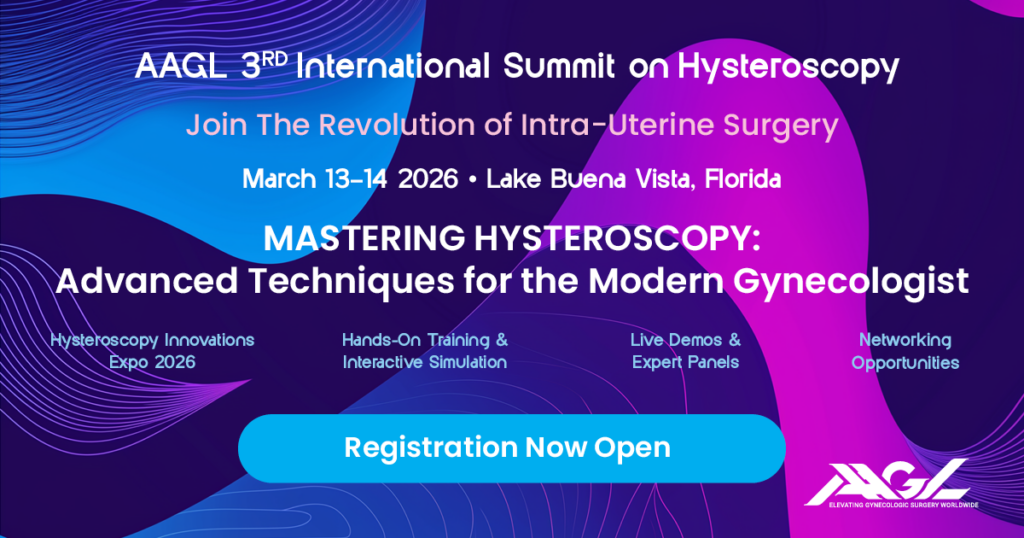EMIG: Milestones and Beyond

History/Background
AAGL initiated the Essentials in Minimally Invasive Gynecology (EMIG) program to meet a need for standardized assessment of physicians performing minimally invasive gynecologic surgery (MIGS). It has been well established that patients benefit greatly from minimally invasive surgical options, with numerous studies showing significantly lower morbidity, mortality, pain and hospital stay while affording faster recovery and return to productivity. The techniques of laparoscopic and hysteroscopic surgery have expanded rapidly to effectively address a multitude of pathologies and procedures that were once unimaginable. However, a reproducible mechanism for teaching and assessing these skills has lagged, leading to the recognition that there is an urgent need for more objective evaluation of surgical skills and competencies. It has become clear that the old adage “See one, Do one, Teach one” is no longer an acceptable model for surgical education and that simulation can provide tremendous preparation of our trainees before participating in surgery.
Why did AAGL create EMIG?
The limited duty hours and available resources in residency education, with an ever-expanding body of knowledge, and surgical approaches have led to inconsistency in adequately training our residents for MIGS. These factors, together with the absence of a standardized mechanism for measuring the proficiency and skill of the individual surgeon, led the AAGL to undertake the admirable mission of developing a standardized laparoscopic, as well as hysteroscopic, simulation protocol useful for training, and assessment, combined with a comprehensive didactic curriculum and a Gyn-specific cognitive exam. Traditional laparoscopic simulation programs were developed by general surgeons for general surgery trainees, with largely irrelevant didactics, and a lack of hysteroscopic simulation.
The AAGL contracted with a psychometrician and created a steering committee of Subject Matter Experts to aid in the development process. The psychometrician worked closely with the AAGL steering committee to provide guidance throughout the process using best practices established by professional testing standards and guidelines. Following a rigorous 10-step program outlined by the group, the AAGL developed a validated cognitive test. A similar process was used to develop measurable hysteroscopic and laparoscopic skill exercises that test the unique psychomotor skills needed for MIGS. The skill exercises were validated to determine that they reliably differentiate minimally proficient surgeons from highly proficient surgeons. AAGL has completed the 2nd beta testing program that serves as a prelude to a national validation testing process. This construct validation study evaluated trainees and gynecologic surgeons, distributed among three levels of proficiency in several regions of the United States, to account for regional training variations. The important beta testing aspect is a pre-validation process, designed to fine tune the testing instruments and exercises, including aspects of the simulators themselves, as well as the training program for test monitors/proctors. Simulators to be used for training were also specifically designed to simulate pelvic and hysteroscopic surgery. This work has produced two assessments – one cognitive, and one psychomotor skill- based that serve to measure both knowledge and technical skills of the aspiring MIGS surgeon.
What are the components of EMIG?
EMIG is comprised of the following three parts:
1) A validated cognitive examination (a second full beta test will be completed by year-end);
2) An accompanying web-based didactic component of 80 video modules, accredited for 10 AMA PRA Category 1 credits; and
3) A manual skills training and testing platform of hysteroscopic and laparoscopic exercises specific to gynecologic surgery.
Cognitive Examination – Background
The EMIG Cognitive Exam was designed to test basic knowledge of laparoscopy, hysteroscopy, electrosurgery, and complications. The exam is expected to be delivered via a web-based testing system platform that uses remote proctoring via webcam.
Cognitive Blueprint
The Cognitive Blueprint consists of 12 subject areas that comprise a total of 88 objectives defined by Subject Matter Experts and evaluated by way of surveying 300 gynecologic surgeons. The Cognitive exam is in its final stages of validation, having just completed a 2nd beta exam with physicians of various levels of expertise (Novice, Proficient & Expert). These physicians took an online proctored exam that will be used to select the final question bank. Because this exam is new, the only means for gathering empirical data to perform a statistical validation is to conduct a pre-test, referred to as a beta exam. The beta exam is our opportunity to administer the items to the target audience to see how the questions perform. This beta exam has more items than will ultimately be needed to meet the exam blueprint so poorly performing items can be eliminated, leaving only items with good statistics to be used to determine pass/fail status and validate the test.
Web Based Didactic
The EMIG web based didactic content consists of twelve video modules, with a total of eighty narrated videos, built from the cognitive exam blueprint. The didactic content has been certified for eleven hours of CME credits and each of these video modules is mapped to the corresponding element in the EMIG Cognitive Blueprint. The videos are delivered in high definition on AAGL’s SurgeryU platform. This is the only such educational offering of its kind with laparoscopy, hysteroscopy, electrosurgery and complications content categories. A summary of the twelve video modules is listed below. You must be a member in good standing to access these videos on SurgeryU.
Module 1: General Endoscopic Principles
Module 2: Applied Anatomy and Physiology
Module 3: Instrumentation
Module 4: Energy Sources
Module 5: Operating Room/Equipment Set Up
Module 6: Laparoscopy Specific
Module 7: Hysteroscopy Specifics
Module 8: Laparoscopy Procedures
Module 9: Hysteroscopy Procedures
Module 10: Laparoscopy Complications
Module 11: Hysteroscopy Complications
Module 12: Special Considerations
AAGL will be offering the EMIG Didactic to serve as a curriculum to guide practicing physicians and subspecialty fellows in the performance of basic and advanced endoscopic surgery.
EMIG Skills Training and Testing Platform
In June 2020, AAGL announced publication of study results from a landmark nationwide trial of the AAGL’s Essentials in Minimally Invasive Gynecology (EMIG) manual skills. The full manuscript entitled “Essentials in Minimally Invasive Gynecology (EMIG) Manual Skills Construct Validation Trial” by Dr. Malcolm G. Munro, et al. has been published with open access online in the June 2020 edition of Obstetrics & Gynecology (the Green Journal), the official publication of the American College of Obstetricians and Gynecologists.
The primary objective of the study was to establish or refute validity for the EMIG Manual Skills Construct by distinguishing novice residents in obstetrics and gynecology (PGY-1) from mid-training residents (PGY-3) during the first 100 days of their training year. Secondary aims included the ability to distinguish “proficient” (ABOG-certified without additional fellowship training) from “expert” practicing surgeons who had completed an accredited two-year fellowship in minimally invasive gynecologic surgery (FMIGS). The validation of EMIG skills was the result of a collaboration by the AAGL, the American College of Obstetricians and Gynecologists (ACOG), and the Council on Resident Education in Obstetrics and Gynecology (CREOG) to develop a system for training in, and evaluation of, endoscopic surgical skills. EMIG is uniquely applicable to gynecologic trainees and is based upon rigorously applied psychometric principles.
What’s Next for EMIG?
EMIG, one of AAGL’s most ambitious endeavors, has had a banner year. Providing our video curriculum in MIGS to over 300 residents, along with completing the validation and 2nd beta exam, have been critical milestones in moving EMIG forward. EMIG sets the standard for training and evaluation in gynecologic laparoscopy and hysteroscopic surgery. We plan to make the program available for remote virtual proctoring and testing of our fellows and residents, potentially adding an integral component of manual skills assessment to our residency training programs and offering an assessment tool and recognition of surgical skills for our international colleagues.
Future directions include interpretation of the didactic content and cognitive test and to make the EMIG test available for our colleagues worldwide. The EMIG Steering Committee aims to strengthen our EMIG research, building a mechanism for encouraging research proposals, an expert review process and grant resources, and for aspiring fellows and members to strengthen the body of evidence of EMIG.
As we continue to make strides in the EMIG validation process, the EMIG Steering Committee will guide the business development of the EMIG program, following through on the AAGL Executive Board’s recommendations for implementation of the EMIG Cognitive Exam, Curriculum, and Skills Test. We are reaching our EMIG goals and soon it will be time to celebrate! We would like to take this opportunity to express our appreciation and gratitude for the countless hours and dedication of the AAGL members, volunteers, AAGL staff and Subject Matter Experts.






